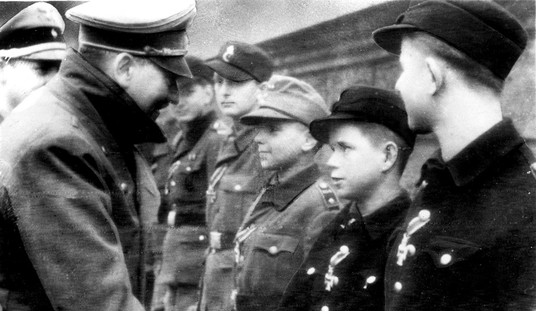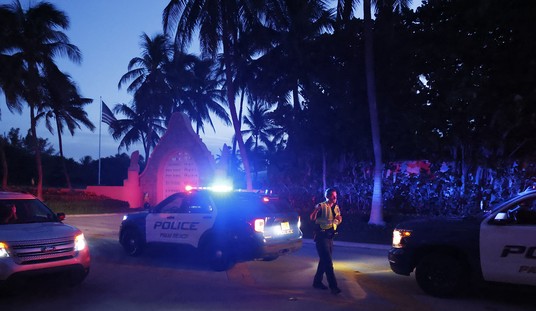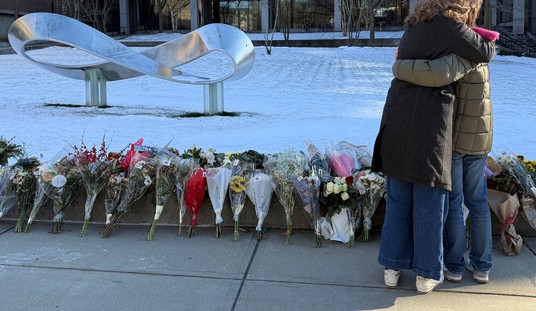At 14 minutes past midnight, on 30 July 1945, midway between Guam and Leyte Gulf, she was hit by two torpedoes out of six fired by the I-58, a Japanese submarine. The first blew away the bow, the second struck near midship on the starboard side adjacent to a fuel tank and a powder magazine. The resulting explosion split the ship to the keel, knocking out all electric power. Within minutes she went down rapidly by the bow, rolling to starboard.
Of the 1,196 aboard, about 900 made it into the water in the twelve minutes before she sank. Few life rafts were released. Most survivors wore the standard kapok life jacket. Shark attacks began with sunrise of the first day and continued until the men were physically removed from the water, almost five days later.
Few World War II incidents have more tragedy rolled into a very short period of time than that of the USS Indianapolis. A secret mission so she wasn’t missed. Denied escorts. Routed through an area known to contain Japanese submarines. Her captain scapegoated at a court of inquiry and eventually dead by his own hand. But in an incident that was basically forced from national memory until this scene from the 1975 motion picture Jaws.
[youtube]https://www.youtube.com/watch?v=jMl1NbR0h_A[/youtube]
there were incidents of true heroism.
Lt. (Rev.) Thomas M. Conway, a 37-year-old Navy Chaplain from Buffalo, New York, was sleeping soundly on July 31, 1945, on board the USS Indianapolis, a heavy cruiser. At 12:14 a.m. the first torpedo from the Japanese submarine, I-58, blew away the bow of the ship. An instant later the second struck near midship on the starboard side, the resulting explosion split the ship to the keel, knocking out all electric power. Within 12 minutes the unescorted cruiser slipped beneath the surface of the Philippine Sea, midway between Guam and Leyte Gulf.Of 1,196 men on board, approximately 900 men made it into the water. Few life rafts were released; the majority of the survivors wore the standard kapok life jacket and life belts. The ship was never missed, and by the time the survivors were spotted by accident four days later, only 316 men were still alive. For three nights Fr. Conway, a Catholic priest, swam to the aid of his shipmates, reassuring the increasingly dehydrated and delirious men with prayers until he himself expired, the last Catholic chaplain to die in WWII.
Now an additional injustice has been perpetrated. A veterans group has been pressing the case to have Chaplain Conway awarded the Navy Cross, the second highest Navy combat decoration:
The U.S. Navy has rejected the Navy Cross for a ‘heroic’ chaplain who died while ministering to sailors in shark-infested waters after their ship was torpedoed during World War II.
Lt. Thomas Michael Conway, a Catholic priest from Buffalo, New York, reportedly spent three nights praying with those aboard the USS Indianapolis in the Philippine Sea until he drowned aged 37.
A Veterans Memorial Committee in Waterbury, where Conway was born, appealed to the Navy last year in a bid to get his actions recognized but the case has now been denied.
This would have placed Chaplain Conway in the company of chaplains such as Father Vincent Capodanno, Father Emil Capuan, the Four Chaplains, and others who gave their lives for their flocks. The first two, like the proposed award for Father Conway were to be posthumous awards for events that happened decades ago. For better or worse, the Obama administration has turned awarding posthumous decorations, years after the fact, into a spectator sport:
With the ornate White House East Room as backdrop, the March 18 ceremony will mark another step to revisit a history of discrimination in the armed forces as the nation’s demographics and social values shift rapidly.
The recipients, whom the White House announced Friday afternoon, served in World War II, Korea, and Vietnam. Collectively, their award ceremony will mark the single largest group of Medal of Honor recipients since World War II, when more than two dozen service members were honored in that conflict’s last days.
Very few, if any, of these awards were subjected to the same regulatory mumbo-jumbo as Chaplain Conway’s which can only lead you to the conclusion that the Chaplain was doubly unfortunate: he was on the USS Indianapolis and he wasn’t a racial, ethnic, or religious minority.















Join the conversation as a VIP Member